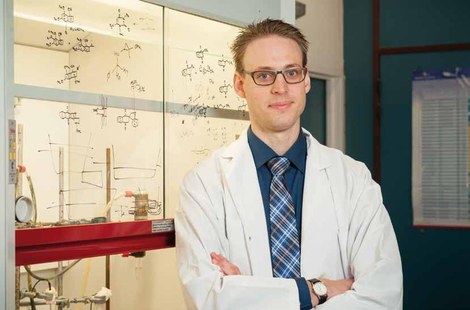Exploring the chemical space - Matthias D'hooghe
With the first human on Mars, space travel has made a giant leap forward in recent decades. Just like astronauts, chemists dream of long journeys and adventurous explorations through space, albeit the ‘chemical space’...
The American Chemical Society describes organic chemistry as “a highly creative science in which chemists explore the properties of existing compounds and create new molecules”. Especially the latter aspect is of particular importance to the ‘chemist-astronaut’: the chemical space – the number of small, biologically interesting molecules that could theoretically exist – is estimated at more than 1060. Today, only a minimal fraction thereof is known. Even though many millions of new compounds have been discovered and developed over the centuries, all these molecules were very similar in structure until about 2030 – they occupied the same small place in chemical space. In other words, chemists had been driving in circles for decades...
That had a lot to do with the limitations of organic chemistry at that time: a limited number of chemical reactions, which in turn could only be applied to a limited number of molecules. The latter limitation was overcome in the period 2025-2035 by advances in automation and robotics: the 'lab coat chemist' had to make way for synthesis robots, which are not only much faster and better, but can also handle reagents that we preferred not to use until 2030 (e.g. for safety reasons). Artificial intelligence has also become more important, with synthesis robots able to design and execute complex chemical syntheses almost autonomously in 2050. In order to be able to manage all of this efficiently, chemists now more than ever benefit from a thorough training in chemistry and engineering skills – a perfect match with our Bioscience Engineering in Chemistry education…
In recent decades, these technological evolutions, grafted on the implementation of sustainable processes and techniques, have indeed allowed us to discover new parts of the chemical space, and nowadays completely new (heterocyclic) structures are central to the fields of e.g. medicine and phytopharmacy. However, if we really want to develop groundbreaking new molecules, chemical reactivity should undergo a further revolution as well. A special challenge in that regard concerns the principle of atom swapping, in which a particular atom in an existing molecule can be replaced by another atom. A simple technique to replace carbon atoms by nitrogen atoms – unthinkable in 2020 – seems to be within reach now, and might even be Nobel Prize material. Anyway, the advent of synthesis robots and other technology definitely means that a chemical laboratory looks completely different as compared to 50 years ago, except maybe for a (slightly older and nostalgic) chemist who still prefers to set up an experiment in a corner of the lab with glass flasks, coolers and other fragile material, like in the good old days...

